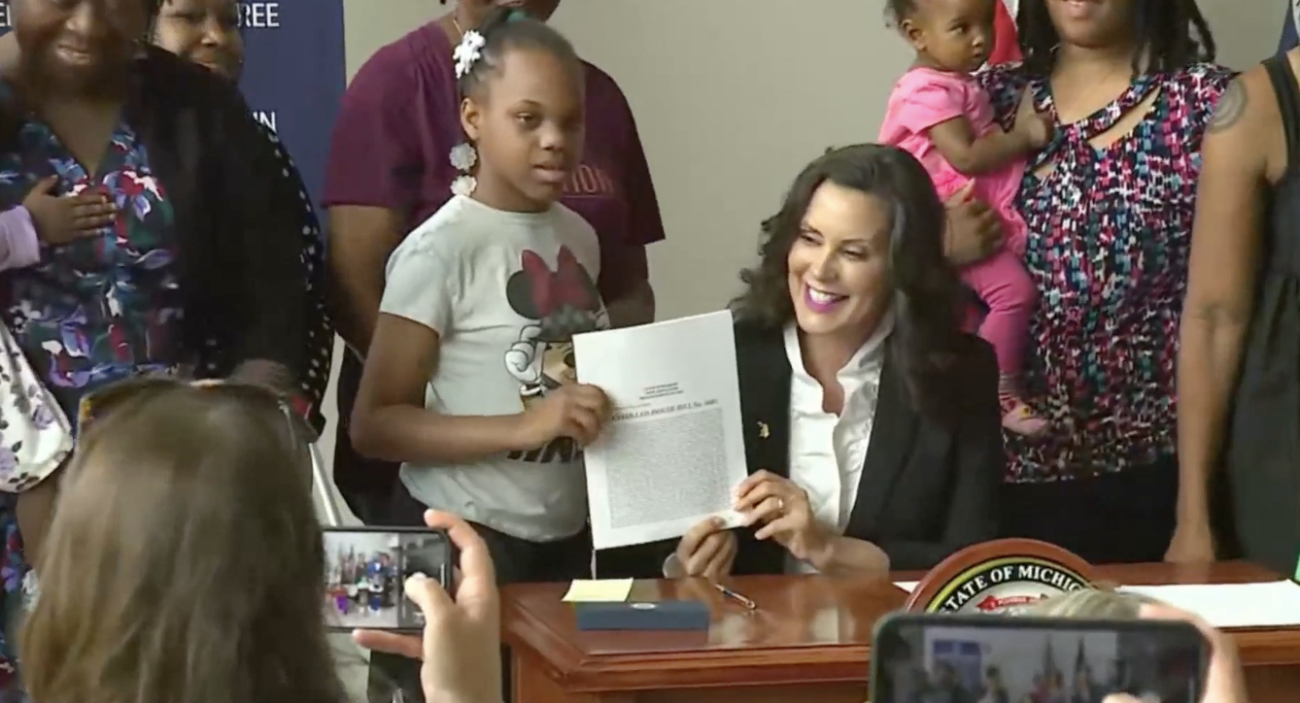Michigan school funding bump varies by district. See how much yours will get

- Michigan’s new education budget includes $500 million in extra classroom funding for traditional public schools
- But the amount each district receives will vary under the deal, which does not include a traditional per-pupil increase
- Instead, the budget will reimburse schools for retirement fund contributions, and those depend on district payroll
Michigan schools will share an estimated $500 million funding bump next year under the state budget Gov. Gretchen Whitmer signed Tuesday, but some districts will get less money than others.
For the first time in more than a decade, the new budget does not include an increase in the per-pupil foundation allowance that typically funds classroom operations.
Instead, the deal negotiated by Whitmer and legislative Democrats will reimburse traditional public schools for some of their required payments into the Michigan Public Schools Employees’ Retirement System, which varies by district.
The result? On a per-pupil basis, some school districts will receive more money than others, ranging from just $9 for a tiny island district in Bois Blanc to $1,458 for the similarly small Elm River Township School District in Houghton, according to estimates from the Senate Fiscal Agency and provided by Senate Democrats.
Related:
- In Michigan school budget, pork flows to Democratic districts
- School officials ‘appalled’ by Michigan budget cut to mental health, safety
Elsewhere, Grand Blanc Community Schools in Genesee County is set to receive $2.6 million in additional funding, the equivalent of $343 per student. The $5.8 million for Grand Rapids amounts to $421 per pupil, the $8.6 million for Ann Arbor is the equivalent of $509 per student, and the $25.2 million for Detroit amounts to $525 per pupil.
Use the searchable database in this story to look up your district.
All told, Michigan is putting $598 million toward reimbursing groups that participate in the state retirement system, which also includes libraries and community colleges. Local school districts are expected to receive roughly $500 million more combined, according to the Senate analysis.
But because those required contributions depend on a district’s payroll, districts with higher payrolls relative to student enrollment will get a larger per-pupil bump, said Craig Thiel, an education finance expert with the nonpartisan Citizens Research Council of Michigan, in a blog post analyzing the budget deal.
Whitmer has framed the deal as the equivalent of an average increase of $400 per student. And a spokesperson for House Speaker Joe Tate said it will provide a “funding increase for Michigan schools across the board.”
But “it’s disingenuous” to say the funding is equivalent to a foundation allowance increase, “because it’s not,” Thiel told Bridge.
No foundation allowance increase
In signing the $23.4 billion education budget Tuesday in Flint, Whitmer said it “continues an all-time high” per-pupil funding level. But pointing to the district-by-district variance, some school leaders have questioned the fairness of the new state spending plan.
Michigan school groups had advocated for a reduction in required retirement fund contributions, but superintendents told Bridge they are worried the deal does not include the level of certainty as a foundation allowance increase.
Last year’s budget boosted the foundation allowance by $458 per student in every school across the state, save for virtual charter schools, to $9,608. For this year, Whitmer had initially proposed another $241 bump, while the House had proposed $217 and the Senate had proposed $302.
But the final deal dropped any foundation allowance increase in favor of refunds for a portion of what traditional public school districts are obligated to pay into the state retirement system.
Charter schools, which largely do not participate in the state retirement system, will receive a 3.9% increase to their foundation allowance, which amounts to a $375 per student bump.
All schools are expected to see a bump of some kind, but the new budget “creates these huge swings in the amount of funding,” Thiel said.
Michigan lawmakers in recent years closed a longstanding gap in funding per district. But the new budget, Thiel said, amounts to “taking a step backwards” in terms of equally funding districts.
Some Democrats who voted for the budget last month later alleged they were misled by leadership because a separate bill that would have made the retirement savings permanent was not finalized or sent to the governor for signature.
The nonpartisan House Fiscal Agency describes the funding as “ongoing,” but local school leaders who spoke with Bridge said that without additional legislation, they are concerned the new funding may disappear in subsequent budget years, making it hard for them to plan for the future.
Morrice Area Schools, which is set to receive the equivalent of an additional $382 per pupil in the new budget, is in a good spot financially for the upcoming school year, Superintendent Robert Pouch told Bridge.
But with new contract negotiations set to begin with the teachers union this winter, a “one-time payment” from the state makes it difficult to “increase salaries when there’s not a guarantee I’ll have that money the following year,” he said.
Looking forward
State Rep. Angela Witwer, a Delta Township Democrat who chairs the House Appropriations Committee, told Crain’s Detroit lawmakers have “no intention” of lowering their financial commitments to school districts in future years.
House Speaker Joe Tate’s office also defended the new budget.
“The fact the required contributions to retirement costs are based on a percentage of payroll creates a disincentive for districts to hire teachers as it grows payroll and increases costs, directing dollars away from the classroom and to retirement benefits costs that are already adequately funded,” Tate spokesperson Amber McCann told Bridge.
She noted the budget also includes new spending on special education, at-risk services, and out of school programming.
But Grant Hegenauer, superintendent of Frankenmuth School District, told Bridge that the funding mechanism in the new budget is “not a fair and equitable way to distribute or recapture money.”
His district is poised to receive an increase of $323 more per student, according to the Senate analysis, which is less than the $400 average increase Whitmer has touted.
Hegenauer said Frankenmuth intends to put the new money the district is getting directly back into staffing and benefits. But it is “one-time,” he said, so the district will have to “hold off” on long-term commitments as well.
David Ehlers, superintendent of Coloma Community School District, told Bridge he thinks he will be able to sustain mental health and school safety programming in the 2024-2025 school year but worries the following year will be harder.
Coloma district is expected to get the equivalent of $350 per student in additional money from the new state budget, less than the $400 statewide average.
Choosing to give districts a boost in funding through reducing retirement fund contributions, he said, is not the kind of “apples to apples increase” that school districts receive when the foundation allowance goes up.
Michigan Education Watch
Michigan Education Watch is made possible by generous financial support from:
Subscribe to Michigan Health Watch
See what new members are saying about why they donated to Bridge Michigan:
- “In order for this information to be accurate and unbiased it must be underwritten by its readers, not by special interests.” - Larry S.
- “Not many other media sources report on the topics Bridge does.” - Susan B.
- “Your journalism is outstanding and rare these days.” - Mark S.
If you want to ensure the future of nonpartisan, nonprofit Michigan journalism, please become a member today. You, too, will be asked why you donated and maybe we'll feature your quote next time!





